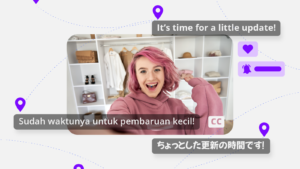Accessibility and engagement are paramount considerations for ensuring a fulfilling learning experience for all. Among the various tools and features available to achieve these goals, subtitles stand out as a particularly powerful asset. In this article, we’ll explore how subtitles enhance accessibility and engagement in e-learning environments, making education more inclusive and effective than ever before.
Accessibility: Breaking Down Barriers
Accessibility lies at the heart of inclusive education, ensuring that learners of all abilities can access and benefit from educational content. Subtitles play a pivotal role in this regard by providing a text-based representation of audio content. For individuals with hearing impairments, subtitles serve as a vital tool for following along with lectures, presentations, and multimedia materials. Moreover, subtitles benefit non-native speakers by offering a written counterpart to spoken language, aiding comprehension and language acquisition.
By incorporating subtitles into e-learning platforms, educators can remove barriers to learning and create an environment where every learner has the opportunity to thrive. Whether it’s a video lecture, a webinar, or an instructional module, subtitles ensure that educational content is accessible to all, regardless of auditory ability or language proficiency.
Engagement: Enhancing Learning Experiences
Beyond accessibility, subtitles also play a crucial role in enhancing engagement and enriching learning experiences for all learners. Research has consistently shown that the combination of visual and auditory stimuli leads to improved information processing and retention. By providing a visual representation of spoken content, subtitles reinforce key concepts and facilitate deeper comprehension.
Moreover, subtitles cater to diverse learning preferences and styles, accommodating visual learners who benefit from reading alongside listening. This multisensory approach not only fosters engagement but also encourages active participation and interaction with the material. Learners can pause, rewind, and review content at their own pace, reinforcing their understanding and addressing any areas of confusion or difficulty.
Best Practices for Subtitle Implementation
To leverage the full potential of subtitles in e-learning environments, it’s essential to adhere to best practices:
- Accuracy: Ensure that subtitles accurately reflect the spoken content, including nuances of language and context.
- Synchronization: Align subtitles with the corresponding audio or video to maintain coherence and clarity.
- Consistency: Maintain a consistent style and formatting for subtitles across all educational materials to enhance readability and user experience.
- Accessibility Standards: Follow accessibility guidelines such as Web Content Accessibility Guidelines (WCAG) to ensure that subtitles are accessible to users with disabilities and compatible with assistive technologies.
By implementing subtitles effectively and thoughtfully, educators can create an inclusive and engaging learning environment that caters to the diverse needs and preferences of all learners.
Adding Subtitles The Easy Way
Long gone are the days where you manually transcribe and add subtitles to your videos word for word. Educators creating e-learning content can now incorporate subtitles into their e-learning content with AI-powered tools like Auris AI. By leveraging advanced algorithms, these platforms automate the process of transcribing and synchronizing subtitles, saving educators valuable time and effort. With Auris AI, educators can upload their audio or video files, and the platform generates accurate subtitles in a matter of minutes. This streamlined approach can save educators hours of their time, where they can focus on developing their educational content instead.
Conclusion
Incorporating subtitles into e-learning content is not merely a matter of compliance; it’s a commitment to accessibility, inclusivity, and learner-centered education. By providing a text-based representation of audio content, subtitles break down barriers to learning and empower individuals of all abilities to access educational materials. Moreover, subtitles enhance engagement, comprehension, and retention, enriching the overall learning experience for all learners. As we continue to harness the power of technology in education, let’s ensure that accessibility and engagement remain a cornerstone of e-learning environments, giving every learner the opportunity to succeed.






